- Home
- Franz Kafka
Amerika: The Missing Person: A New Translation, Based on the Restored Text
Amerika: The Missing Person: A New Translation, Based on the Restored Text Read online
Cover of the first edition of Der Heizer (The Stoker),
which later became the first chapter of Der Verschollene
(The Missing Person). Subtitled “A Fragment,” the story
was published in Germany in 1913 by Kurt Wolff Verlag
as part of a series of works by promising new writers
called Der Jüngste Tag (The Last Judgment).
Amerika:
The Missing Person
CONTENTS
_________
Title Page
Publisher’s Note
Translator’s Preface
I The Stoker
II The Uncle
III A Country House Outside New York
IV The March to Ramses
V At the Occidental Hotel
VI The Robinson Affair
The suburban street in which the automobile . . .
“Up! Up!” cried Robinson . . .
FRAGMENTS
Brunelda’s Departure
At a street corner Karl saw . . .
They traveled for two days . . .
Acknowledgments
Chronology
Bibliography
Also by Franz Kafka
Copyright
PUBLISHER’S NOTE
______________
Dearest Max, my last request: Everything I leave behind me . . . in the way of diaries, manuscripts, letters (my own and others’), sketches, and so on, [is] to be burned unread. . . .
Yours, Franz Kafka
These famous words written to Kafka’s friend Max Brod have puzzled Kafka’s readers ever since they appeared in the postscript to the first edition of The Trial, published in 1925, a year after Kafka’s death. We will never know if Kafka really meant for Brod to do what he asked; Brod believed that it was Kafka’s high artistic standards and merciless self-criticism that lay behind the request, but he also believed that Kafka had deliberately asked the one person he knew would not honor his wishes (because Brod had explicitly told him so). We do know, however, that Brod disregarded his friend’s request and devoted great energy to making sure that all of Kafka’s works—his three unfinished novels, his unpublished stories, diaries, and letters—would appear in print. Brod explained his reasoning thus:
My decision [rests] simply and solely on the fact that Kafka’s unpublished work contains the most wonderful treasures, and, measured against his own work, the best things he has written. In all honesty I must confess that this one fact of the literary and ethical value of what I am publishing would have been enough to make me decide to do so, definitely, finally, and irresistibly, even if I had had no single objection to raise against the validity of Kafka’s last wishes. (From the postscript to the first edition of The Trial)
Schocken Books would like to acknowledge the scholarly assistance given by Professor Mark Anderson and Dr. Anthony David Skinner in the preparation of this note.
In 1925, Max Brod convinced the small avant-garde Berlin publisher Verlag Die Schmiede to publish The Trial, which Brod prepared for publication from Kafka’s unfinished manuscript. Next he persuaded the Munich publisher Kurt Wolff to publish his edited manuscript of The Castle, also left unfinished by Kafka, in 1926, and in 1927 to bring out Kafka’s first novel, which Kafka had meant to entitle Der Verschollene (The Missing Person), but which Brod named Amerika. The first English translation of The Trial, by Edwin and Willa Muir (who had already translated The Castle in 1930), appeared in 1937 simultaneously in England and the United States, the latter edition published by Knopf with illustrations by Georg Salter. Neither the German nor the English-language editions sold well, although they were critically well received. Edwin and Willa Muir’s translation of Amerika was first published in the United States in 1940 by New Directions.
Undeterred, Max Brod enlisted the support of Martin Buber, André Gide, Hermann Hesse, Heinrich Mann, Thomas Mann, and Franz Werfel for a public statement urging the publication of Kafka’s collected works as “a spiritual act of unusual dimensions, especially now, during times of chaos.” Since Kafka’s previous publishers had closed during Germany’s economic depression, he appealed to Gustav Kiepenheuer to undertake the project. Kiepenheuer agreed, but on condition that the first volume be financially successful. But the Nazi rise to power in 1933 forced Kiepenheuer to abandon his plans. Between 1933 and 1938 German Jews were barred from teaching or studying in “German” schools, from publishing or being published in “German” newspapers or publishing houses, or from speaking and performing in front of “German” audiences. Publishers that had been owned or managed by Jews, such as S. Fischer Verlag, were quickly “Aryanized” and ceased to publish books by Jews. Kafka’s works were not well enough known to be banned by the government or burned by nationalist students, but they were “Jewish” enough to be off limits to “Aryan” publishers.
When the Nazis introduced their racial laws they exempted Schocken Verlag, a Jewish publisher, from the ban against publishing Jewish authors on condition that its books would be sold only to Jews. Founded in 1931 by the department store magnate Salman Schocken, this small publishing company had already published the works of Martin Buber and Franz Rosenzweig as well as those of the Hebrew writer S. Y. Agnon as part of its owner’s interest in fostering a secular Jewish literary culture.
Max Brod offered Schocken the world publishing rights to all of Kafka’s works. This offer was initially rejected by Lambert Schneider, Schocken Verlag’s editor in chief, who regarded Kafka’s works as outside his mandate to publish books that could reacquaint German Jewry with its distinguished heritage. He also doubted its public appeal. His employer also had his doubts about the marketability of six volumes of Kafka’s novels, stories, diaries, and letters, although he recognized their universal literary quality as well as their potential to undermine the official campaign to denigrate German Jewish culture. But he was urged by one of his editors, Moritz Spitzer, to see in Kafka a quintessentially “Jewish” voice that could give meaning to the new reality that had befallen German Jewry and would demonstrate the central role of Jews in German culture. Accordingly, Before the Law, an anthology drawn from Kafka’s diaries and short stories, appeared in 1934 in Schocken Verlag’s Bücherei series, a collection of books aimed to appeal to a popular audience, and was followed a year later—the year of the infamous Nuremberg Laws—by Kafka’s three novels. The Schocken editions were the first to give Kafka widespread distribution in Germany. Martin Buber, in a letter to Brod, praised these volumes as “a great possession” that could “show how one can live marginally with complete integrity and without loss of background” (from The Letters of Martin Buber [New York: Schocken Books, 1991], p. 431).
Inevitably, many of the books Schocken sold ended up in non-Jewish hands, giving German readers—at home and in exile—their only access to one of the century’s greatest writers. Klaus Mann wrote in the exile journal Sammlung that “the collected works of Kafka, offered by the Schocken Verlag in Berlin, are the noblest and most significant publications that have come out of Germany.” Praising Kafka’s books as “the epoch’s purest and most singular works of literature,” he noted with astonishment that “this spiritual event has occurred within a splendid isolation, in a ghetto far from the German cultural ministry.” Quite probably in response to Mann’s article, on 22 July 1935, a functionary of the German cultural ministry wrote to Schocken complaining that the publisher was “still selling the complete works of Franz Kafka, edited by Max Brod,” although the work of both Kafka and Brod had been placed by the Nazis on the “list of ha
rmful and undesirable writings” three months earlier. Schocken moved his production to Prague, where he published Kafka’s diaries and letters. Interestingly, despite the Nazi protest against the collected works, he was able to continue printing and distributing his earlier volume of Kafka’s short stories in Germany itself until the government closed down Schocken Verlag in 1939. The German occupation of Prague that same year put an end to Schocken’s operations in Europe.
In 1939, he reestablished Schocken Books in Palestine, where he had lived intermittently since 1934, and editions of Kafka’s works in the renewed Hebrew language were among its first publications. In 1940, he moved to New York, where five years later he opened Schocken Books with Hannah Arendt and Nahum Glatzer as his chief editors. While continuing to publish Kafka in German, Schocken reissued the existing Muir translations of the novels in 1946 and commissioned translations of the letters and diaries in the 1950s, thus placing Kafka again at the center of his publishing program. Despite a dissenting opinion from Edmund Wilson in The New Yorker (where he nonetheless compared Kafka to Nikolai Gogol and Edgar Allan Poe), a postwar Kafka craze began in the United States; translations of all of Kafka’s works began to appear in many other languages; and in 1951 the German Jewish publisher S. Fischer of Frankfurt (also in exile during the Nazi period) obtained the rights to publish Kafka in Germany. As Hannah Arendt wrote to Salman Schocken, Kafka had come to share Marx’s fate: “Though during his lifetime he could not make a decent living, he will now keep generations of intellectuals both gainfully employed and well-fed” (letter, 9 August 1946, Schocken Books Archive, New York).
Along with the growing international recognition of Franz Kafka as one of the great modern writers, scholars began to raise doubts about the editorial decisions made by Max Brod. Although the manuscript of Der Verschollene (The Missing Person) lacks chapter headings and often even chapter breaks, Kafka did jot down on a sheet of paper headings for the first six chapters (complete with page numbers). He left no such instructions for the remainder of the text. After Kafka’s premature death in 1924 of tuberculosis, Brod did everything he could to achieve for his friend the recognition that had largely eluded him during his lifetime. As a result, in editing the manuscript of this novel for its original German publication in 1927, Brod was, as he explained in his afterword, “primarily concerned with the broad line of the story, not with philological work.” While he followed Kafka’s stated intentions for those first six chapters, he divided the remainder of the text into two additional chapters, for which he devised the headings “A Refuge” and “The Nature Theater of Oklahoma.” In the case of the latter, Brod also rounded off the chapter—and indeed the novel—by adding two final passages that were clearly fragments from a subsequent never-completed chapter. Finally, he relegated to an appendix two passages concerning Karl’s service at Brunelda’s, since they did not, he felt, greatly advance the story.
Salman Schocken was among the most eager for new critical editions of Kafka’s works. “The Schocken editions are bad,” he wrote in an internal memo. “Without any question, new editions that include the incomplete novels would require a completely different approach” (29 September 1940, Schocken Archives, Jerusalem). However, Max Brod’s refusal to give up the Kafka archive in his Tel Aviv apartment or to allow scholars access to it made such new editions impossible until 1956, when the threat of war in the Middle East prompted him to deposit the bulk of the archives, including the manuscript of The Castle, in a Swiss vault. When the young Oxford Germanist Malcolm Pasley learned of the archives’ whereabouts, he received permission from Kafka’s heirs in 1961 to deposit them in Oxford’s Bodleian Library, where they were subsequently made available for scholarly inspection. The manuscript of The Trial, which Kafka had given to Brod in 1920, remained in Brod’s personal possession, passing to his companion and heiress Ilse Ester Hoffe when he died in 1968. It was not until the late 1980s that Ms. Hoffe agreed to sell the manuscript, which was auctioned for a record sum by Sotheby’s in November 1988 to the German national literary archives in Marbach, where it is now kept.
Since 1978 an international team of Kafka experts has been working on German critical editions of all of Kafka’s writings, which are being published by S. Fischer Verlag with financial support from the German government. The first of these editions, Das Schloss (The Castle), edited by Malcolm Pasley, appeared in 1982 in two volumes, the first containing the restored text of the novel drawn from Kafka’s handwritten manuscript, the second containing textual variants and editorial notes. Mark Harman’s translation of the restored text was published by Schocken in 1998. The critical edition of Der Verschollene (The Missing Person), edited by Jost Schillemeit, appeared in 1983, also in two volumes. Harman’s translation is based on the re stored text in the first volume, which corrected numerous transcription errors in the earlier editions and removed Brod’s editorial and stylistic interventions. In the restored text, for example, Schillemeit employs only the chapter headings mentioned by Kafka and inserts chapter or section breaks based on evidence gleaned from the manuscript.
This translation generally follows the example set by the editors of the critical editions, although, as Harman explains in his preface, a few inconsistencies have been silently rectified (for example, Kafka’s erratic spelling of New York as Newyork or New-York and the odd use of capitals in “Hotel occidental”). As in the case of our new translations of The Trial and The Castle, we have not included the variants and deleted passages that appeared in the second volume of the critical editions of these books. The chief objective of these new translations, intended for the general public, is to provide readers with versions that reflect as closely as possible the state in which Kafka left the manuscripts.
TRANSLATOR’S PREFACE
______________
There is little doubt that Karl Rossmann, the young hero of The Missing Person, who is banished to America by his parents, was Kafka’s favorite alter ego. On sending his future fiancée, Felice Bauer, the first chapter, he urged her to receive the “little youth kindly, set him down beside you and praise him, as he so longs to be praised.”1 Readers will, I hope, not only come to share Kafka’s affection for Karl, as I did while working on this translation, but also gain a new appreciation for this novel, which has for too long been overshadowed by The Trial and The Castle. If approached afresh, this book could bear out the early claim by Kafka’s friend Max Brod that “precisely this novel . . . will reveal a new way of understanding Kafka.”2
The Missing Person is a poetically coherent work that can be read on a number of levels, as an episodic picaresque tale, a bildungsroman or coming-of-age novel, a story of emigration or exile, a dark vision of urban civilization, a self-reflective modernist novel, and finally an at times dryly humorous send-up of the American dream. In creating his vision of America, Kafka was inspired by sources ranging from newspaper accounts of America, writings by European travelers, silent movies, and possibly the autobiography of Benjamin Franklin—which he pointedly gave to his own father to read3—as well as an established tradition of German-language writing about America, in which the New World was portrayed either as an idyllic refuge or as a dystopia.4
As his diaries and letters suggest, Kafka’s fascination with America grew out of a sense of imprisonment or inner exile. His native city Prague, which he once famously called a “little mother with claws,” could never be his Heimat (home or homeland). In a diary entry of 20 August 1911 he writes of wanting to spread himself out “in all earthly directions,” as he may be said to have done vicariously in his first novel.5 This desire to break away from Prague, even if only in his imagination, never left him. Toward the end of his life, on seeing a group of refugees packed into the banqueting room of the Jewish Town Hall in Prague, he writes to his lover Milena Jesenská: “If I’d been given the choice to be what I wanted, then I’d have chosen to be a small Eastern Jewish boy in the corner of the room, without a trace of worry, the father in the centre discussing with othe
r men, the mother, heavily wrapped, is rummaging in the traveling bundles . . . and in a few weeks one will be in America.”6
When this novel first appeared in London in 1938 in Edwin and Willa Muir’s beautiful English translation, there was little awareness of what Kafka knew about America, and, since he himself had never set foot on these shores, it was easy to dismiss what he liked to call his “American novel” as sheer fantasy. However, thanks to meticulous scholarly reconstructions of the annihilated world of the German-speaking Prague Jews and of the debates about literature, religion, philosophy, Jewish identity, and Zionism in which Kafka participated, The Missing Person no longer seems quite so ahistorical, nor so apolitical, as it once did.
Although Kafka never crossed the Atlantic, he had specific ideas about the kind of America he wanted to portray. For instance, when, on the suggestion of the poet Franz Werfel, his German publisher Kurt Wolff used an old-fashioned print of a sailing boat approaching New York Harbor as a frontispiece for “The Stoker”—the first chapter of the novel, which was initially published in 1913 as a separate story—Kafka protested on the grounds that he had portrayed “the most modern New York.”7
Together with “The Judgment” and “The Metamorphosis,” “The Stoker” forms a trilogy of what Kafka dubbed his domestic tragedies. All three stories feature sons who are punished by their parents, and the manuscripts attest to the close relationship between these three characters: on several occasions in “Metamorphosis” Kafka wrote “Karl” rather than “Gregor” (the main protagonist in “Metamorphosis”), and similarly five times in the manuscript of “The Stoker” he mistakenly wrote “Georg” (the hero of “The Judgment”) instead of “Karl.”8 Three days after achieving what he considered his literary breakthrough, in writing “The Judgment” during the night of 22–23 September 1912, he began to compose his “American novel.”

 Diaries of Franz Kafka
Diaries of Franz Kafka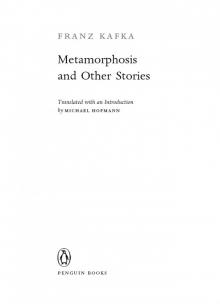 Metamorphosis and Other Stories
Metamorphosis and Other Stories The Castle: A New Translation Based on the Restored Text
The Castle: A New Translation Based on the Restored Text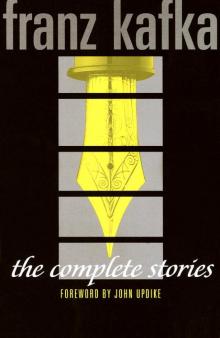 The Complete Stories
The Complete Stories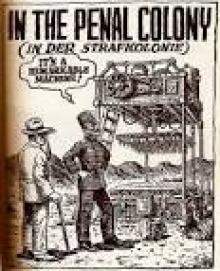 In the Penal Colony
In the Penal Colony The Trial
The Trial Amerika
Amerika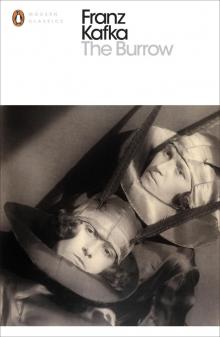 The Burrow: Posthumously Published Short Fiction
The Burrow: Posthumously Published Short Fiction Sons
Sons Letters to Milena
Letters to Milena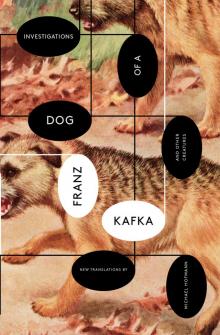 Investigations of a Dog: And Other Creatures
Investigations of a Dog: And Other Creatures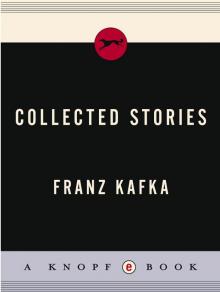 Collected Stories
Collected Stories The Great Wall of China
The Great Wall of China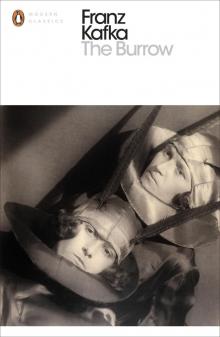 The Burrow
The Burrow The Castle
The Castle The Meowmorphosis
The Meowmorphosis The Sons
The Sons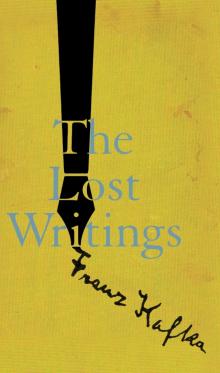 The Lost Writings
The Lost Writings The Unhappiness of Being a Single Man
The Unhappiness of Being a Single Man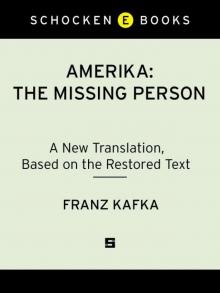 Amerika: The Missing Person: A New Translation, Based on the Restored Text
Amerika: The Missing Person: A New Translation, Based on the Restored Text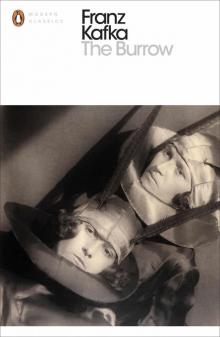 The Burrow: Posthumously Published Short Fiction (Penguin Modern Classics)
The Burrow: Posthumously Published Short Fiction (Penguin Modern Classics) The Diaries of Franz Kafka
The Diaries of Franz Kafka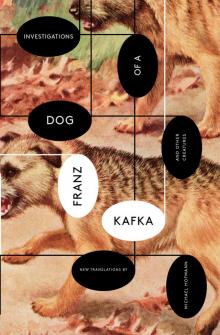 Investigations of a Dog
Investigations of a Dog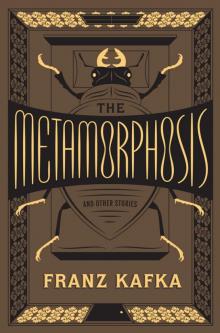 The Metamorphosis and Other Stories
The Metamorphosis and Other Stories The Trial: A New Translation Based on the Restored Text
The Trial: A New Translation Based on the Restored Text